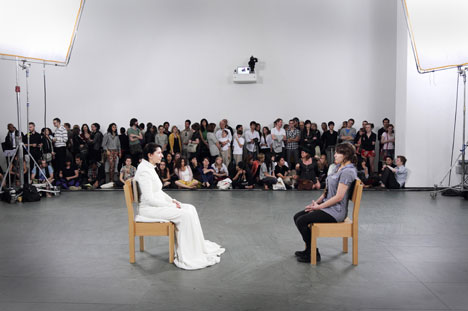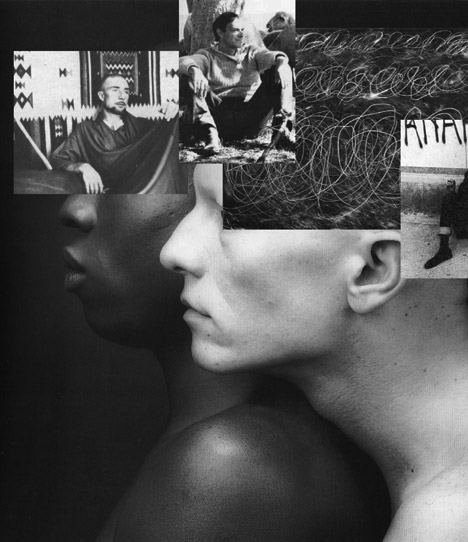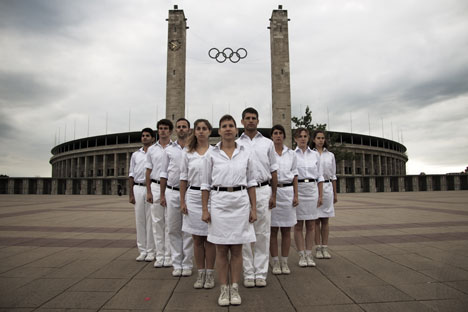Art Monthly 349
September 2011
Marina Abramovi?
Interviewed by Iwona Blazwick
Re-Performance Art
Henry Lydiate and Daniel McClean
11 Rooms
Stephanie Schwartz
Art/Writing
John Douglas Millar
Buy Now – select:
Want to read this right now?
Get instant access to the entire back catalogue via Exact Editions from only £8.99!
Contents

Marina Abramovic The Artist is Present 2010
Interview
The Artist is Present
Marina Abramovic interviewed by Iwona Blazwick
Marina Abramovic is arguably the most important contributor to the field of performance art, having produced highly influential work back in the 1970s and – unlike many of her peers – continuing to produce radical performances today. Here she discusses her cultural influences, the dfficulties of re-performance, and what happens when you sit still for three months, seven hours at a time.
'You know performance really has the power to change not just the performer's life but also the one who is witnessing the performance. I truly believe that only long durational work has that kind of power because if you do a performance for one hour, two hours, five hours – you can still pretend. You can still act. You can still be somebody else. But if you do something for three months, it's life itself.'

Karl Holmqvist page from Facehug issue 1 2007
Feature
Art/Writing
John Douglas Millar on why experimental writing thrives in the art world
There has been an upsurge in experimental writing, but why has it found its home in the art world rather than the literary industry? Is there a fundamental difference in how writers find audiences within these fields?
'While academic and creative disciplines cross pollinate in the art world, they seem increasingly estranged in the literary world. The result is that the influence of experimental and avant-garde fiction waxes in the world of art while it wanes in the world of publishing.'
Comment
Editorial
London's Burning
The world of citizen journalism and its image making came into its own during the recent riots, but what do the iconic images, and the stories behind them, tell us of community life in the UK's inner cities?
'One image has already emerged as iconic, that of the young woman – a glowing red silhouette against a fiery yellow background – jumping out of a first floor window into outstretched arms below. The scene was a rented flat in Coydon; the young woman, Monika Konczyk, is from Poland; while the man who eventually caught her, known only as "Adrian from Romania", was a neighbour.'
Artnotes
The government's plans for an 'endowments century' are fleshed out and immediately come under attack; a report points out the value of small arts organistions, particularly to larger organisations; ACE launches its new approach to diversity; Charles Jencks interferes with England's northern border landscape, with a little help from Cecil Balmond; all the latest news on galleries, art world prizes and more.
Submissions: Send Artnotes info to artnotes@artmonthly.co.uk
Reviews
Exhibitions
11 Rooms
Manchester Art Gallery
Stephanie Schwartz
Folkestone Triennial
various venues
David Trigg
Allan Sekula: Polonia and Other Fables
Belfast Exposed
Chris Clarke
Michelangelo Pistoletto: The Mirror of Judgement
Serpentine Gallery, London
Kathy Noble
Atsuko Tanaka: The Art of Connecting
Ikon, Birmingham
Martin Herbert
Darrell Viner
Henry Moore Institute, Leeds
David Briers
Paul Etienne Lincoln: An Aurelian Labyrinth and Other Explications
South London Gallery
Laura Allsop
Ryan Trecartin: Any Ever
MoMA PS1, New York
Katie Kitamura
Outrageous Fortune: Artists Remake the Tarot
Focal Point Gallery, Southend-on-Sea
Peter Suchin
The Wonders of the Invisible World
NGCA, Sunderland
Paul Usherwood
Rain
Cell Project Space, London
Chris Fite-Wassilak
Narrative Show
Eastside Projects, Birmingham
Chris Fite-Wassilak
Archipelago
CGP, London
Eliza Williams
Reviews
Books
ARTocracy and Parade
Jennifer Thatcher tackles two different approaches to public art events
'A new type of artistic and curatorial practice has emerged that takes place in the public realm but can't easily be subsumed under the familiar category of "public art". This new art favours a more ad-hoc, self-organising structure, a socially engaged agenda, and a discursive attitude to the term "public".'
Adrian Piper: Race, Gender and Embodiment
Maria Walsh on John P Bowles's thorough analysis of Piper's practice
'This book could have been subtitled "Race, Gender and Objecthood", as what comes across most strikingly and poignantly in John P Bowles's attempt to locate Adrian Piper's work at the nexus of conceptual and feminist art of the late 1960s and 70s is her use of herself as an object.'
Reviews
Performance
Mel Brimfield: This is Performance Art
David Briers on a fake history of performance
'Bizarrely plausible are refernces to Joseph Beuys's forgotten ukulele skills and his appearance with a wolf on Animal Magic. A frenzied student disco party sequence from Flashdance is identified as documentary footage of the Judson Dance Theater Collective.'
This is Not a Performance or a Lecture!
Morgan Quaintance on a day of lecture performances
'Instead of a day spent shuffling from neutral space to neutral space, attendants, a map and a timetable guided the collective audience across the university's prodigious grounds. Loughborough boasts the largest single-site campus in the UK and use of its lecture halls, theatres and £36m state-of-the-art sports facilities were offered to the performers.'
Reviews
Film
Experimental Film Round-up
Maxa Zoller on the latest screenings
'So far, the year 2011 has produced many angry crowds. From the "Arab Spring" to the UK student movement, the relationships between the common, community and communication are shifting. In London a number of experimental film screenings responded to these issues.'
Salerooms
London
Public Galleries and the Market
Colin Gleadell on record prices and public/private entanglements
'According to a lawsuit filed by the Michael Werner Gallery in New York to stop the sale, the seller, James H Rich, had acquired Peter Doig's painting Red Boat (Imaginary Boys) from them in 2004 for a bargain $162,000 on the condition that it would eventually be gifted to the Carnegie Museum of Art, of which Rich is a trustee. In the event, it shot over estimate and sold for £6m to a private US collector.'
Artlaw

Public Movement 2009 official group photograph outside the Olympic Stadium in Berlin
Performance
Performance Art and the Law
Henry Lydiate and Daniel McClean explore the legalities around performance art in a feature-length article
'In "The Artist is Present" exhibition of 2010, Marina Abramovic instructed others to re-perform earlier pieces she had made in collaboration with her former partner, Ulay (Uwe Layspien), which included re-performing Imponderabilia, 1977.'
Listings
Exhibitions
Exhibition listings
Art Monthly's exhibition listings can also be viewed online.











